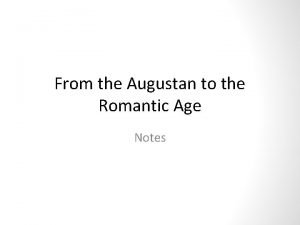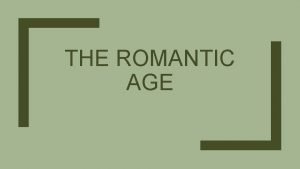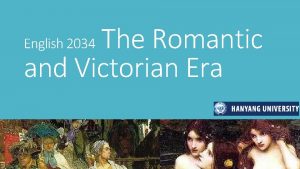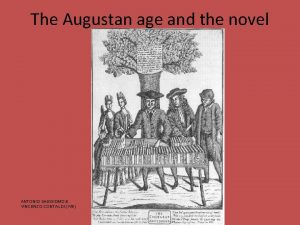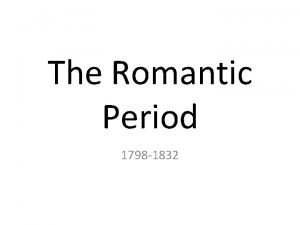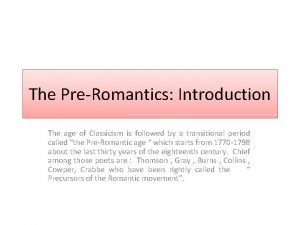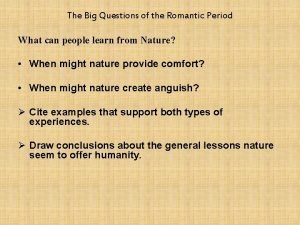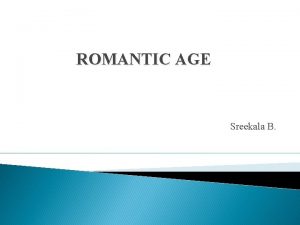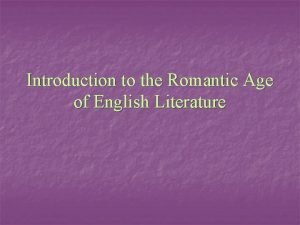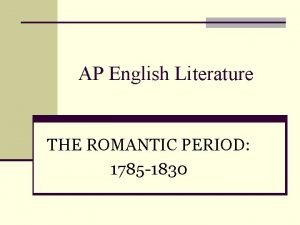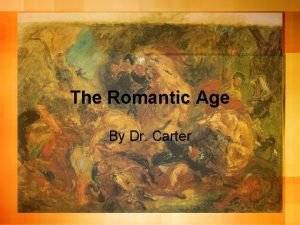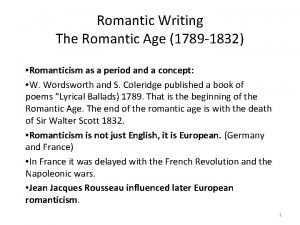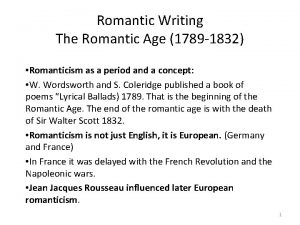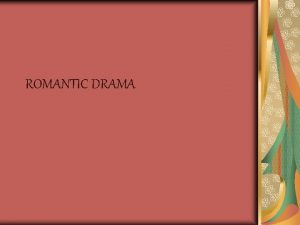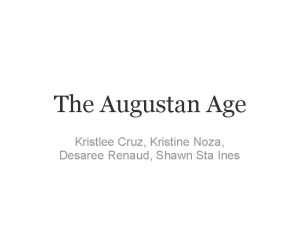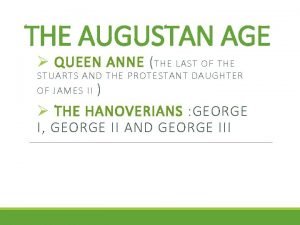From the Augustan to the Romantic Age Notes












- Slides: 12

From the Augustan to the Romantic Age Notes

1714 (George I, beginning of the dynasty of Hanover) – 1760 (death of George II) • The Augustan Age • The Enlightenment • The Neoclassical Age

Augustan Age • Emperor Augustus 27 b. C. – 14 a. D. • some artists of the time used the expression themselves (indicating they had Horace, Virgil and Ovid as models) • internal political stability • expanding colonial empire • technological progress in industry and agriculture growth of Britain as a leading political and commercial country

Enlightenment • remarkable progress in natural science • application of the scientific method to other areas of life • Royal Society (founded in 1622): development of art and science, meeting point for scientists • Isaac Newton (1642 -1727): universe explained in logical terms • rational approach even to religious matters (Deism)

Neoclassicism • attempt at reproducing the formal perfection of classical writers • strict observation of rules in metre and rhyme • creation of a poetic diction → an artificial, stereotyped language, removed from everyday language, only appropriate for poetry • desire for order, balance, rationality

• A time of political stability, traditionalism, elegance, wit, optimism, faith in progress • Idea of the imitation of nature ↓ woods, rivers, mountains, human nature the universe; the divine rules regulating it, shown in the creation

• focus on the power of REASON / COMMON SENSE • growing emphasis on the culture of the heart, on SENSIBILITY, on individual judgement • expansion of the MIDDLE CLASS • coffee houses

• JOURNALISM • the NOVEL Defoe Swift Fielding Richardson Sterne

• however, a trend of subjective, meditative trends never disappeared • became evident especially in the final part of the century, the so-called Early Romantic Age or Pre-Romantic Age • love of nature, interest in folklore, a tendency to mystery and melancholy, the Gothic trend

THE ROMANTIC AGE -from 1760 (beginning of George III’s reign) to 1832 (First Reform Act) or 1837 (Victoria’s accession to the throne) 1798/1800 Lyrical Ballads (the ‘Preface’) -meaning and use of the term «romantic» -an age of REVOLUTION ü American ü French ü Industrial

• a European phenomenon, with three main branches: German, French, English • in Italy it officially started in 1816; strong nationalistic elements, best expressed in poetry and the novel • Sturm und Drang, 1770 s; philosophical character • French Romanticism, esp represented by drama and literary criticism; influence of Rousseau

• a complex, various cultural movement, with some key ideas ü stress on the imagination and individual experience ü conception of the artist as an original creator free from strict adherence to models and rules ü notion of nature as a living being, closely connected to the divine ü idea of the child as unspoiled by society and civilization
 Augustan age notes
Augustan age notes Augustan poetry aim
Augustan poetry aim Romantic age and victorian age
Romantic age and victorian age Stone age chronology
Stone age chronology Iron age bronze age stone age timeline
Iron age bronze age stone age timeline Augustan novel
Augustan novel Augustan period
Augustan period Romantic period 1798 to 1832
Romantic period 1798 to 1832 Pre romanticism
Pre romanticism Questions about romanticism
Questions about romanticism Queen mab characteristics
Queen mab characteristics Romantic literature definition
Romantic literature definition Romanticism vs enlightenment
Romanticism vs enlightenment
